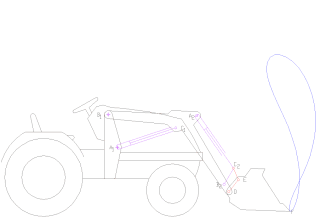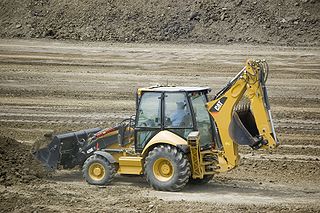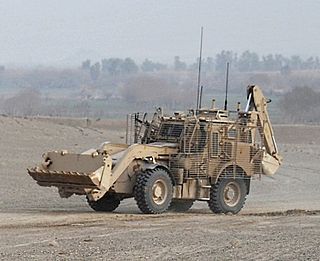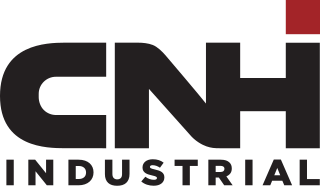
Excavators are heavy construction equipment consisting of a boom, dipper, bucket and cab on a rotating platform known as the "house". The house sits atop an undercarriage with tracks or wheels. They are a natural progression from the steam shovels and often mistakenly called power shovels, as power shovels may have similar looking buckets. All movement and functions of a hydraulic excavator are accomplished through the use of hydraulic fluid, with hydraulic cylinders and hydraulic motors. Due to the linear actuation of hydraulic cylinders, their mode of operation is fundamentally different from cable-operated excavators, which use winches and steel ropes to accomplish the movements.

A loader is a heavy equipment machine used in construction to move or load materials such as soil, rock, sand, demolition debris, etc. into or onto another type of machinery.

A backhoe—also called rear actor or back actor—is a type of excavating equipment, or digger, consisting of a digging bucket on the end of a two-part articulated arm. It is typically mounted on the back of a tractor or front loader, the latter forming a "backhoe loader". The section of the arm closest to the vehicle is known as the boom, while the section that carries the bucket is known as the dipper, both terms derived from steam shovels. The boom, which is the long piece of the backhoe arm attached to the tractor through a pivot called the king-post, is located closest to the cab. It allows the arm to pivot left and right, typically through a range of 180 to 200 degrees, and also enables lifting and lowering movements.

A backhoe loader, also called a loader backhoe, loader excavator, tractor excavator, digger or colloquially shortened to backhoe within the industry, is a heavy equipment vehicle that consists of a tractor-like unit fitted with a loader-style shovel/bucket on the front and a backhoe on the back. Due to its (relatively) small size and versatility, backhoe loaders are very common in urban engineering and small construction projects as well as developing countries. This type of machine is similar to and derived from what is now known as a TLB (Tractor-Loader-Backhoe), which is to say, an agricultural tractor fitted with a front loader and rear backhoe attachment.

Heavy equipment, heavy machinery, earthmovers, construction vehicles, or construction equipment, refers to heavy-duty vehicles specially designed to execute construction tasks, most frequently involving earthwork operations or other large construction tasks. Heavy equipment usually comprises five equipment systems: the implement, traction, structure, power train, and control/information.

Volvo Construction Equipment - Volvo CE - is a major international company which develops, manufactures, and markets equipment for construction and related industries. It is a subsidiary and business of the Volvo Group.
Joseph Cyril Bamford, CBE was a British businessman. He was the founder of J.C. Bamford Excavators Limited (JCB), a manufacturer of heavy equipment.

Case Construction Equipment is an Italian manufacturer of construction machinery. Along with CASE IH, Case Construction Equipment is a brand of CNH. Case produces construction equipment including excavators, motor graders, wheel loaders, vibratory compaction rollers, crawler dozers, skid steers, and compact track loaders.

BEML Limited, formerly Bharat Earth Movers Limited, is an Indian public sector undertaking which manufactures a variety of heavy equipment, such as that used for earth moving, railways, transport and mining. It is headquartered in Bangalore. BEML is Asia's second-largest manufacturer of earth moving equipment. Its stock trades on the National Stock Exchange of India under the symbol "BEML", and on the Bombay Stock Exchange under the code "500048".

A compact or mini excavator is a tracked or wheeled vehicle with an approximate operating weight from 0.7 to 8.5 tonnes. It generally includes a standard backfill blade and features independent boom swing.

HD Hyundai (Korean: HD현대) is one of the largest South Korean conglomerates engaged in shipbuilding, heavy equipment, machinery, and the petroleum industry.

Tata Hitachi Construction Machinery Company Pvt Ltd or THCMC is an India-based joint venture company between Tata Motors of India and Hitachi Construction Machinery of Japan. It was previously known as Telco Construction Equipment Co. Ltd. or Telcon for short.
ENMTP is an Algerian company specializing in the development, manufacture and distribution of machinery used in public works. It has registered capital of 15.6 billion DA and is 100% owned by the state.
Anthony Paul Bamford, Baron Bamford, is a British billionaire businessman who is the chairman of J.C. Bamford Excavators Limited (JCB). He succeeded his father, Joseph Cyril Bamford, as chairman and managing director of the company in 1975, at the age of 30. He was knighted in 1990 at the age of 45. He has appeared in the Sunday Times Rich List, and in 2021 his net worth was estimated at US$9.48 billion. Bamford is a car collector whose collection includes two examples of the rare Ferrari 250 GTO, valued upwards of $70 million each.
Steelfab was a Cardiff, Wales-based engineering firm that built the "Steelfab Digger", a competitor to the HyMac and JCB excavators in the 1960s. The company also built the Horndraulic brand of front loaders for fitting to agricultural tractors.

New Holland Construction is an American manufacturer of construction machinery. Along with New Holland Agriculture, New Holland Construction is a brand of CNH. New Holland Construction produces construction equipment including backhoes, excavators and loaders.

The JCB HMEE is a military engineering vehicle made by JCB.

CNH Industrial N.V. is an Italian-American multinational corporation with global headquarters in Basildon, United Kingdom, but controlled and mostly owned by the multinational investment company Exor, which in turn is controlled by the Agnelli family. The company is listed on the New York Stock Exchange. The company is incorporated in the Netherlands. The seat of the company is in Amsterdam, Netherlands, with a principal office in London, England.
Hidromek is a heavy equipment manufacturer founded in Ankara in 1978.
Joseph Cyril Edward Bamford is a British businessman and investor. He is the owner of Wrightbus, a UK-based bus manufacturer.


















